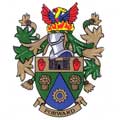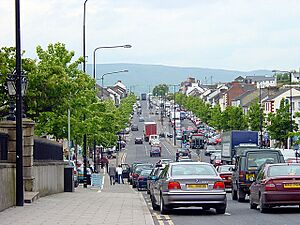Cookstown facts for kids
Quick facts for kids Cookstown
|
|
|---|---|
 Cookstown coat of arms |
|
| Population | 12,546 (2021 Census) |
| Irish grid reference | H8178 |
| • Belfast | 47 miles |
| District |
|
| County | |
| Country | Northern Ireland |
| Sovereign state | United Kingdom |
| Post town | COOKSTOWN |
| Postcode district | BT80 |
| Dialling code | 028 |
| Police | Northern Ireland |
| Fire | Northern Ireland |
| Ambulance | Northern Ireland |
| EU Parliament | Northern Ireland |
| UK Parliament |
|
| NI Assembly |
|
| Website | http://www.midulstercouncil.org |
Cookstown (which is An Chorr Chríochach in Irish) is a town in County Tyrone, Northern Ireland. It is the fourth-largest town in County Tyrone. In the 2021 census, about 12,546 people lived there. Cookstown is one of the main towns in the Mid-Ulster area, along with Magherafelt and Dungannon.
The town was started around 1620. An English lawyer named Dr. Alan Cooke leased the land from the Archbishop of Armagh. The Archbishop had received these lands after an event called the Flight of the Earls during the Plantation of Ulster. Cookstown was an important center for making linen products. Until 1956, many steps of making linen, like spinning and weaving, happened in the town.
Contents
History of Cookstown
In 1609, land in the area was leased to Dr. Cooke. He agreed to build houses there. In 1628, King Charles I gave Dr. Cooke permission to hold a market twice a week. People could sell livestock and linen goods at this market.
In 1641, the native Irish people rebelled against the new settlers, called Planters. The town of Cookstown was destroyed during this rebellion. This event stopped the town's growth for almost 100 years. Over time, William Stewart of Killymoon bought up the lands around Cookstown. By 1671, the Stewart family owned all the lands that Dr. Cooke once had.
William Stewart and his son James made plans for a new town. They were inspired by the "Wide Streets Commission" in Dublin. They designed Cookstown with a wide, tree-lined main street, which was about 135 feet (41 meters) wide.
In 1802, Colonel William Stewart asked a famous architect named John Nash to rebuild Killymoon Castle. Nash also designed another building, the Rectory at Lissan, in 1807.
Cookstown grew a lot in the 1800s because of the linen trade. Gunning's Linen Weaving Mill had over 300 looms. Two different railway lines also built railway stations in Cookstown. The Belfast and Northern Counties Railway operated from 1856 to 1955, and the Great Northern Railway operated from 1879 to 1959.
In the late 1800s, the Church of the Holy Trinity on Chapel Street was built.
On 17 June 1920, during the Irish War of Independence, a group called the Irish Republican Army (IRA) raided the police station in Cookstown. One IRA member, Patrick Loughran, was killed during this event.
Cookstown Town Hall was designed by Charles Geoffrey Birtwell and opened on 27 May 1953. Later, in 1998, the Town Hall was taken down. The Burnavon Arts and Cultural Centre opened in its place in 2000.
During a period of conflict known as the Troubles, Cookstown faced challenges, including some bomb attacks.
Places to Visit
- The Ardboe High Cross and Abbey is about 10 miles (16 km) from Cookstown. It is one of the best examples of a very old stone cross from the 9th or 10th century in Ireland. It is the only part left of an early monastery that used to be there.
- Other old sites nearby include the Beaghmore stone circles. These are ancient circles made of stones.
- Tullyhogue Fort is near the village of Tullyhogue. This was an important place where the chiefs of Tyrone, the O'Neills, were officially made leaders a long time ago.
- The Donaghrisk walled cemetery is near the fort. This is where the O'Hagans, who were the chief judges of Tyrone, are buried. They were in charge of the O'Neills' inauguration ceremonies.
- Lissan House is just outside Cookstown. It is a large house that was home to the Staples family for 350 years.
- Killymoon Castle is about 1 mile (1.6 km) south-east of Cookstown. This castle is considered one of Cookstown's most beautiful old buildings. It was built in just over a year and was the first project in Ireland for the architect John Nash.
- Drum Manor is about 5 miles (8 km) from the town. A man named Alexander Richardson bought the land in 1617 and built Drum Manor. His family lived there for many years.
- St Luaran's Church of Ireland church is on Church Street.
- The Catholic church, dedicated to the Holy Trinity, was built between 1855 and 1860. It has a tall tower and spire.
- Derryloran Old Cemetery is a historic graveyard on the edge of town. It has an old churchyard that dates back to the 1600s.
Climate
Cookstown has a typical climate for Northern Ireland, with mild temperatures and rainfall throughout the year.
Townlands
A "townland" is a small area of land in Ireland. Here are some townlands within Cookstown's urban area and what their names might mean:
- Clare (from Clár meaning "level land")
- Cookstown (an English name from Alan Cooke)
- Coolkeeghan (from Cúil Caocháin meaning "Keighen's corner")
- Coolnafranky (from Cúil na Francaigh meaning "corner of the rats" or "French")
- Coolnahavil (from Cúil na hAbhaill meaning "corner of the orchard")
- Coolreaghs (from Cúil Riach meaning "grey corner")
- Gortalowry (from Gort an Leamhraigh meaning "field of the elm place")
- Loy (from Láigh meaning "hill")
- Maloon (from Magh Luan meaning "plain of the lambs")
- Monrush (from Móin Rois meaning "wooded peatland")
- Sullenboy (from Sailean Buí meaning "yellow willows")
- Tullagh (from Tulach meaning "hilltop")
Cookstown Townland
The Cookstown townland itself is in the historic area called the barony of Dungannon Upper. It is also in the civil parish of Derryloran and covers about 217 acres (88 hectares).
The number of people living in this specific townland grew during the 1800s:
| Year | 1841 | 1851 | 1861 | 1871 | 1881 | 1891 |
|---|---|---|---|---|---|---|
| Population | 27 | - | 16 | 123 | 119 | 93 |
| Houses | 5 | 1 | 4 | 23 | 28 | 22 |
Sports in Cookstown
Motorcycling
Cookstown hosts the Cookstown 100 Road Races. This is the oldest motorcycle road race in Ireland. It happens every April and kicks off the Irish National Road Racing Championship.
Gaelic Football
Cookstown Fr. Rock's is the local Gaelic Athletic Association club. They won the All-Ireland Intermediate Club Football Championship in 2013.
Association Football
Local association football (soccer) clubs include Cookstown Olympic F.C. (an intermediate-level club), Mid-Ulster Ladies F.C. (a women's club), Killymoon Rangers F.C., Coagh United F.C., and Sofia Farmer F.C.. These clubs play in different leagues.
Hockey
Cookstown Hockey Club is the town's field hockey team.
Population Information
19th Century Population
The population of Cookstown grew during the 1800s:
| Year | 1841 | 1851 | 1861 | 1871 | 1881 | 1891 |
|---|---|---|---|---|---|---|
| Population | 3006 | 2993 | 3257 | 3501 | 3870 | 3841 |
| Houses | 550 | 576 | 600 | 728 | 822 | 835 |
The Northern Ireland Statistics and Research Agency (NISRA) considers Cookstown a "medium town." This means it has between 10,000 and 18,000 people.
2021 Census
| National Identity of Cookstown residents (2021) | ||||
|---|---|---|---|---|
| Nationality | Per cent | |||
| British | 31.7% | |||
| Irish | 31.3% | |||
| Northern Irish | 28.6% | |||
On census day in 2021, there were 12,546 people living in Cookstown. Here's what the census found:
- About 21% of people were under 16 years old.
- About 64% were between 16 and 65 years old.
- About 15% were 66 years old or older.
- 51% of the population were female, and 49% were male.
- About 56% of people said they were from a Catholic background.
- About 34% said they were from a Protestant or other Christian background.
- About 8% said they had no religious background.
- When asked about their national identity, people could choose more than one option:
- About 32% felt they had a British national identity.
- About 31% felt they had an Irish national identity.
- About 29% felt they had a Northern Irish national identity.
- About 15% of people had some knowledge of the Irish language.
- About 9% had some knowledge of Ulster-Scots.
2011 Census
On census day in 2011, there were 11,599 people living in Cookstown.
- About 98% were from the white ethnic group.
- About 56% were from a Catholic background, and 39% were from a Protestant or other Christian background.
- About 40% felt they had a British national identity, 30% had a Northern Irish identity, and 28% had an Irish identity.
2001 Census
On census day in 2001, there were 10,646 people living in Cookstown.
- About 26% were under 16 years old, and 15.6% were 60 or older.
- About 49.7% were male, and 50.3% were female.
- About 52.8% were from a Catholic background, and 45.1% were from a Protestant background.
- About 3.9% of people aged 16–74 were unemployed.
Education
Cookstown has several schools. Secondary schools (for older students) include Cookstown High School and Holy Trinity College, Cookstown.
For higher education, the Loughry Campus of the College of Agriculture, Food and Rural Enterprise is about 2 miles (3.2 km) south of Cookstown. South West College (a technical college) is also in the area.
Healthcare
Cookstown is getting the first "community hub" for primary healthcare in the area. This new center will have scanning facilities, a minor surgery room, a pharmacy, and places for community healthcare. It might also have supported living homes for older people.
Famous People from Cookstown
Arts
- Jimmy Cricket - a comedian
- Nick Laird - a poet and writer
- Eamonn McCrystal - a singer and broadcaster
- Owen O'Neill - a writer, actor, director, and comedian
- Oliver Sheppard (1865-1941) - a sculptor, born in Cookstown
- Jonathan Swift - stayed at Loughry Manor while writing his famous book Gulliver's Travels
- Lias Saoudi - a musician from the band Fat White Family, who grew up in Cookstown
Business
- Finbarr O'Neill - a former CEO of a company called J.D. Power.
Sports
- Kenny Acheson - a racing car driver
- David Ames - an Olympian in field hockey for Great Britain
- Jacqueline Burns - a footballer for the Northern Ireland women's national football team
- Stuart Dallas - a footballer for the Northern Ireland Team
- Terry Devlin - a footballer for Portsmouth F.C.
- Aaron Hughes - a footballer for the Northern Ireland Team
- Owen Mulligan - a Tyrone GAA footballer
- Ian Sloan - an Olympian in field hockey for Great Britain
- Martin Sloan - a field hockey player, captain of the Ireland men's national field hockey team in the 1990 Men's Hockey World Cup
Politics
- William Craig - a politician, born in Cookstown
- Bernadette Devlin - a political activist, who grew up in Rathbeg
Medical
- Major-General Sir Richard Havelock Charles, 1st Baronet (1858–1934) - a medical doctor who was a surgeon to King George V
- Mary Mallon, also known as Typhoid Mary
Images for kids
See also
 In Spanish: Cookstown para niños
In Spanish: Cookstown para niños







